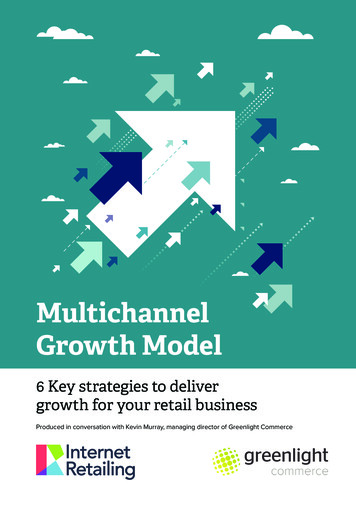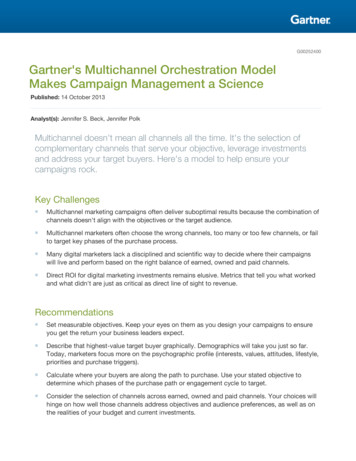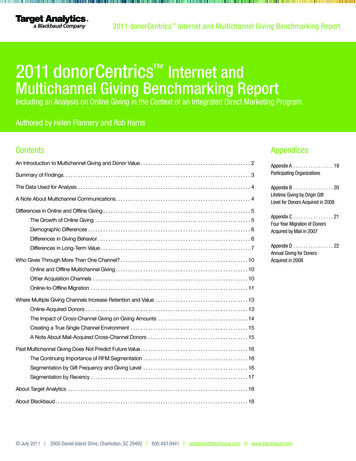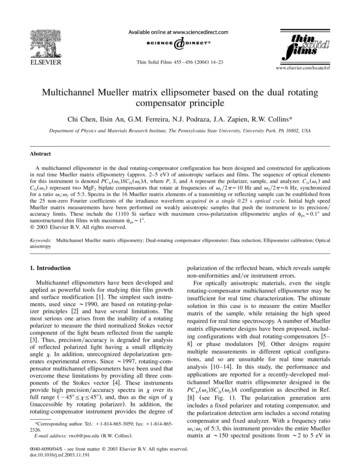
Transcription
MultichannelGrowth Model6 Key strategies to delivergrowth for your retail businessProduced in conversation with Kevin Murray, managing director of Greenlight Commerce
WelcomeBusiness growth. Two simple words that everyIntroducing the growth vectorsbusiness aims for. But how do you define it?What do you need to enable growth? We have,What does growth actually comprise and howin partnership with Greenlight Commerce,can you, as a retailer, meet your growth goalsidentified six areas where concerted efforts willquicker and more easily in a market that isdeliver positive results. Each chapter outlinesmore competitive than ever?areas to focus on; retailers who are great roleDefining growthmodels to follow and provides summary toptips to help you achieve your aims.In this Multichannel Growth Model eBook,Murray, managing director of GreenlightChapters 1, 2 and 3 – Customer,products and services and channelsCommerce, we aim to help you define theThe first three chapters are very closelynotion of growth for your business; understandrelated. Growing your customer base, productthe vectors that will help you achieve thatand services and your channels provides yougrowth and put in place the right foundationswith three key streams with which to wringand platform to deliver upon that promise ofmuch growth out of your business.which is produced in conversation with Kevingrowth – both now and in the longer term.Sounds easy but of course it’s not. EachIt’s a target we all have to deliver on since nodepends on its own strategy, focus andbusiness can be seen to be standing still ifdedication and we examine what’s neededthey want to survive in an ever increasinglyfor each.competitive environment. Executive boardsnewness that can help a company stay vibrant,Chapter 4 – Business operatingmodelrelevant and ahead of the pack.Having the right business operating modeland stakeholders demand the innovation andin place is key to enabling growth and hasBut of course, it’s not easy. While someto be revised and adapted as the businessretailers and brands are fortunate to be simplychanges - otherwise your business willrushed off their feet and grow as if by reflex,simply fall apart under the added strain thatfor the majority it takes planning, alignmentyour efforts to grow place upon it. In thisand commitment and in today’s multichannelchapter we look at how to structure yourworld that means multiple strands of strategybusiness and the KPIs required to supportcombined into one holistic growth aim.profitability and performance.2www.greenlightcommerce.com www.internetretailing.net
Multichannel Growth ModelBusiness as Usual (BAU): doing more of whatyou currently do. Add customers, add productsChapter 5 – Change and innovationand services, and add channels and touchpoints.Business Operating Model: when you’veAlthough the first three growth vectors,improved and extended your BAU as far assupported by the relevant business operatingpossible or profitable, you need to look afreshmodel, will deliver some element of growthat the balance of activities within your business.it is embracing change and innovation thatChange and Innovation: static businesses get leftwill keep you relevant and top of mind forbehind by market moves and trends, and evencustomers. Continually surprising them –unchanging classics need to remain relevant.positively of course – will enable furtherChange is at the heart of a living retailer and wegrowth. In the digital age there is no excuseconsider how to make change an advantage.not to be pushing boundaries beyondMobilisation: an idea remains simply thatanything you have done before, especiallyunless acted upon. A key dimension ofsince if you don’t others will.growth is being able to mobilise a complexAnd finally – Chapter 6 –MobilisationThe first five chapters deal with the moretangible elements of driving growth butenterprise to
that the customer wants to interact with you - whether that's pre-purchase, in-purchase or post-purchase," he says. Whilst building a customer database may be easy, building a database of prospects that are actually likely to convert into paying customers - ideally that return time and time again - is tougher.










